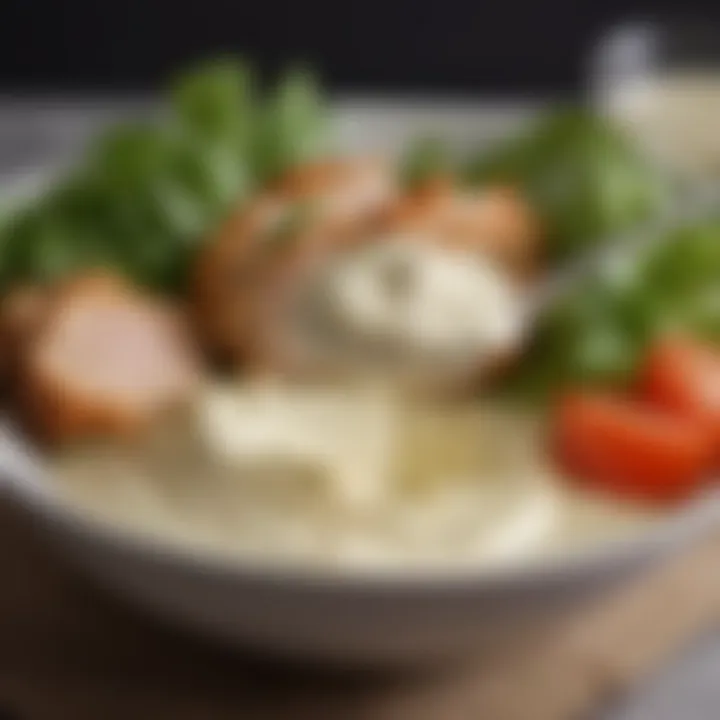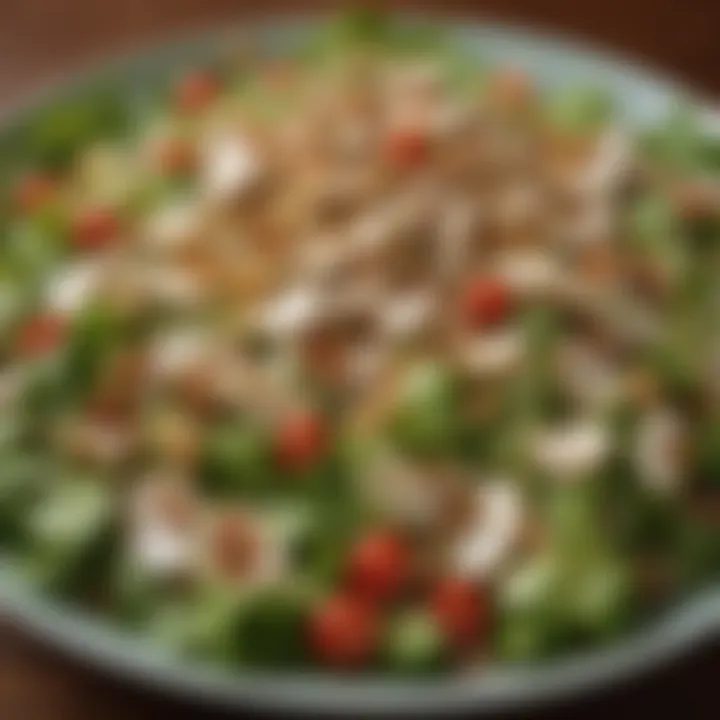Ingredients of Chicken Salad: A Complete Overview


Intro
Chicken salad is more than just a meal; it often serves as a canvas for culinary creativity. This dish, with its roots embedded in traditional American cuisine, has evolved to include a plethora of variations that cater to diverse tastes and dietary needs. From creamy, mayonnaise-laden versions to lighter, vinaigrette-dressed options, chicken salad invites experimentation, making it a favorite for both home cooks and professional chefs.
Understanding the ingredients of chicken salad is key to mastering this dish. Each component plays a role, contributing to flavor, texture, and nutritional value. In this guide, we will explore these essential ingredients, how they interact, and a few tips to help you whip up a delightful chicken salad that will impress both family and friends.
Put on your apron and get ready to dive into the world of chicken salad, where simplicity meets sophistication.
Preamble to Chicken Salad
When it comes to comfort food, few dishes evoke a sense of home and warmth like chicken salad. This dish not only satisfies our hunger but also brings back memories of family gatherings, picnics in the park, and summer barbecues. Chicken salad embodies simplicity and versatility, making it a staple in many cuisines around the world. Understanding its various components can unlock a plethora of flavor profiles and textures, paving the way for culinary creativity.
Origin and Evolution
The roots of chicken salad trace back to ancient times. It's believed that the earliest versions came about when cooked chicken was mixed with herbs and a form of dressing. Recipes have morphed significantly since then, adapting to local tastes and ingredient availability. In the United States, the dish gained popularity in the late 19th century, often served in tea rooms and at luncheons. Over the decades, it evolved from hearty versions laden with heavy mayonnaise to lighter, fresher interpretations that feature a variety of ingredients.
"Chicken salad is not just about mixing; it's about creating a dish that tells a story, reflecting cultural influences and personal tastes."
Today, chicken salad might encompass elements ranging from diced apples and nuts to avocado and fresh herbs. The global influence of ingredients shows how adaptable this dish can be.
Culinary Significance
Chicken salad holds a special place in various culinary traditions. It is more than a mere combination of ingredients; it represents a broader narrative about food culture. This dish can symbolize resourcefulness, as many cooks have learned to make it from leftover or less expensive ingredients. In this way, it has been embraced by everyone from home cooks to gourmet chefs.
Furthermore, chicken salad highlights the importance of balance in cooking. The creamy base, whether it be mayonnaise, yogurt, or something alternative, works hand-in-hand with crisp vegetables and the tender chicken to create a rounded dish. Different flavor pairings—like tart fruits against savory chicken—create a dynamic profile that engages the palate. The significance lies not just in its flavor but in its ability to transform basic components into a dish worth savoring.
Understanding the evolution and significance of chicken salad sets the stage for a deeper exploration into its primary ingredients and how each element contributes to its overall character.
Primary Ingredients in Chicken Salad
When it comes to chicken salad, the primary ingredients not only provide the foundation for the dish but also define its flavor and texture. Understanding the nuances of these ingredients is critical, as they contribute to the overall appeal of chicken salad, making it a versatile choice for many occasions. From a simple lunch to a fancy gathering, these key elements form the backbone of what makes chicken salad so delightful.
Chicken: The Star Ingredient
Chicken is undoubtedly the main attraction in chicken salad, offering a protein-rich base that keeps it both hearty and satisfying. The type of chicken used can make a significant difference in the final product.
Types of Chicken
When selecting chicken, one can choose from a variety of options such as rotisserie chicken, poached chicken breast, or even canned chicken. The key characteristic of each type impacts the dish differently.
- Rotisserie Chicken: This already cooked choice offers convenience and flavors, making it a popular pick among busy individuals. Its savory seasoning enhances the salad without requiring much effort.
- Poached Chicken Breast: Known for its moist texture and mild flavor, this method of preparation ensures the chicken stays juicy. However, it generally requires more prep time.
- Canned Chicken: While some may shy away from this option, it can serve well in a pinch. The benefit lies in its long shelf life and ready-to-use format, but some may find it lacks freshness compared to other methods.
Each type has its unique features—for instance, rotisserie chicken is often praised for its bold flavors, while poached chicken excels in healthiness. On the downside, canned chicken may not appeal to those looking for a fresh taste and texture.
Preparation Methods
The preparation methods used for chicken can significantly alter the chicken salad's flavor profile. Popular methods include grilling, poaching, or baking, each contributing distinct qualities.
- Grilling: This method adds a smoky flavor that can elevate a regular salad to something extraordinary. However, it requires a grill and some more time.
- Poaching: For those wanting a milder taste, poaching in broth keeps the chicken moist and flavorful without heavy oils or fats, but it demands attention to keep the cooking just right.
- Baking: A hands-off method, baking can produce beautifully cooked and tender chicken. Yet, it may take longer than other methods, which could be a consideration for a busy schedule.
Base Ingredients
Next up, the base ingredients work hand-in-hand with chicken to create the creamy, delectable consistency that chicken salad is known for. Here’s where creativity shines.
Mayonnaise


Mayonnaise is often the quintessential ingredient for chicken salad, binding everything together in a creamy embrace. It’s rich texture makes it a beloved option due to its versatility.
- Popular Choice: Many love mayonnaise because of its smooth texture and rich flavor that complements chicken well. It’s a classic for a reason!
- Advantages: The primary advantage of using mayonnaise is its ability to maintain moisture, giving the salad a luscious consistency.
- Disadvantages: On the flip side, some may find it overly rich or not as healthy due to its high-fat content. This may lead some to seek alternatives.
Yogurt vs. Mayonnaise
In the ongoing debate over yogurt versus mayonnaise, both have their merits that cater to different preferences and dietary choices. This section is worth diving deeper into.
- Yogurt: This ingredient brings a tangy flavor and lower fat content, making it a lighter alternative while still providing creaminess.
- Mayonnaise: In contrast, while mayonnaise delivers a richer flavor, it lacks the probiotic benefits found in yogurt.
Each of these brings a unique balance to the dish, so personal preference often governs the choice.
Alternatives for Creaminess
For those seeking to replace traditional mayonnaise, there are alternatives that can bring different qualities to a chicken salad, such as avocado or sour cream.
- Avocado: Packed with healthy fats, it not only adds creaminess but also provides a fresh, vibrant flavor.
- Sour Cream: This ingredient can introduce tanginess, similar to yogurt, but it may lack the smoothness milk fats provide.
The choice of replacement can genuinely shift the flavors and textures created within the dish, providing versatility for various palates and dietary needs.
"Understanding the primary ingredients not only augments one’s culinary arsenal but also enhances the enjoyable experience of crafting chicken salad."
Exploring these elements further illustrates the value of thoughtful selection in creating a chicken salad that satisfies not only the taste buds but also nutritional and aesthetic desires.
Vegetables that Enhance Flavor and Texture
When we think of chicken salad, the protein often takes center stage. However, let’s not forget about the unassuming vegetables that add essential layers of complexity. Vegetables can infuse vibrancy—both in color and taste—into each bowl, playing a crucial role in creating a delightful balance. They not only enhance flavor but also contribute a spectrum of textures that elevate a simple dish into something memorable. The crunch of celery, the bite of onions, and the sweetness of bell peppers bring a multitude of elements that interact harmoniously, making every bite an experience rather than a chore.
Celery: Crunch and Freshness
Celery might seem like just another vegetable on the platter, but its contributions to chicken salad cannot be overstated. Known for its crisp texture, it adds an essential crunch that offsets the creaminess of the base ingredients. A salad without that crunch can feel a bit one-note. Furthermore, celery has a naturally refreshing quality, often bringing a subtle sweetness to the dish, which is a nice contrast to the savory chicken.
Chopping it into small bits ensures that it is evenly distributed, providing texture that keeps the palate engaged. Its high water content can also help lighten the overall feel of the salad, making it feel less heavy than calorie-dense alternatives. This makes celery a staple in many classic chicken salad recipes.
Onions and Their Variants
Onions are one of those ingredients that can easily add depth to a salad. Depending on the variety, they bring different flavors and characteristics that can either uplift or dominate.
Red Onions
Red onions stand out for their striking color and milder flavor compared to their yellow counterparts. The subtle sweetness and slightly peppery undertones help to balance out the richer notes of chicken. When thinly sliced or diced, they provide a punch of flavor that can awaken the other ingredients. Many people find that their vivid color also creates an attractive presentation on the plate, making red onions a popular choice for all sorts of salads. However, some may find red onions a bit strong if used excessively, so moderation is key to maximizing their contribution without overtaking the dish.
Green Onions
Green onions, or scallions as they are sometimes called, bring a lighter taste that complements chicken salad well. With their delicate, mild flavor, they offer a subtle oniony kick without being too overpowering. The green tops, in particular, provide a splash of color, making them a great visual enhancement. Beyond looks, they also offer a layer of freshness serving as a nice contrast against the heavier mayonnaise or yogurt. While they are often less pungent than red onions, some might find them a bit shy when adding a strong onion flavor, which can be both a charm and a drawback depending on your effect.
Bell Peppers: Color and Sweetness
Bell peppers bring a welcome burst of color and a hint of sweetness to chicken salad. Their vibrant hues can transform a plate from drab to fab, adding an inviting visual aspect. This vegetables' sweetness pairs particularly well with the savory chicken, bringing a rounded flavor profile that feels well-rounded yet light.
Chopped bell peppers can add crunch, but they can be difficult if not prepared properly. Cutting them into manageable pieces ensures that they intermingle with the other ingredients, so each forkful provides a balanced taste. They can also be varied—yellow, red, or green—for added visual effect and nuance in flavor. Using bell peppers authentically can introduce various flavor combos, making each preparation unique and more tailored to personal preferences.
Key Takeaway: The right vegetables can truly bring chicken salad to life. Their inclusion provides not only flavor and crunch but also visual appeal, creating a dish that’s as satisfying to look at as it is to eat.
In summary, the vegetables in chicken salad do more than merely fill it out; they enhance the overall experience, contributing to a more enjoyable meal. Their variety allows cooks to explore new flavor dimensions in an otherwise straightforward dish.


Fruits in Chicken Salad
When it comes to crafting a delightful chicken salad, the inclusion of fruits can elevate the dish to new heights. Fruits bring a vibrant freshness that enhances the overall flavor, making every bite a little more exciting. Their natural sweetness balances out savory elements, contributing to a pleasing contrast that refreshes the palate. In this section, we dive into two popular fruits that add both flavor and texture to chicken salad: cranberries and apples.
Cranberries: Tartness and Sweetness
Cranberries, with their distinctive tartness, add a zesty kick to chicken salad. They often appear in dried form, which makes them easy to incorporate without worrying about spoilage. The sweet and sour combination can pique the taste buds, creating an appealing depth of flavor.
Benefits of using cranberries include:
- Nutritional Value: Cranberries are packed with antioxidants, which can be beneficial for overall health. They are also low in calories and high in fiber, promoting a feeling of fullness.
- Colorful Appeal: Their rich red hue stands out against the creamy backdrop of mayonnaise, providing a visually striking contrast that can entice even the pickiest eaters.
- Versatility: Cranberries can be combined with nuts or herbs, perfectly complementing other elements in chicken salad. For instance, a handful of chopped walnuts alongside cranberries creates a satisfying crunch and a range of textures that keep things interesting.
Utilizing cranberries in your chicken salad doesn’t just add flavor. It introduces a playful component that invites diners to enjoy a blend of sweet and savory, enticing both those with a yearning for something tangy and those who lean toward indulgent creaminess.
Apples: Crispness and Flavor
Apples, on the other hand, bring in a different dimension entirely. Their crisp texture provides a satisfying crunch that contrasts beautifully with the juiciness of chicken or the creaminess of dressings. Certain varieties, like Granny Smith and Fuji, offer a refreshing tang that can brighten the dish.
Why Apples Pair Well in Chicken Salad:
- Textural Diversity: Slicing apples adds a crunchy and juicy layer to the salad, which can balance the softness of other ingredients. This incorporation of varying textures enhances the overall eating experience.
- Natural Sweetness: The natural sugars in apples contribute a gentle sweetness, which softens more dominant flavors such as celery or onion. This mild sweetness can also appeal to those who enjoy lighter, fruitier salads.
- Nutritional Benefits: Apples are well-known for their health benefits too. They provide dietary fiber and Vitamin C, making your salad not just a treat for your palate but also a wholesome choice.
By integrating fruits into chicken salad, you open a world of flavor possibilities. These additions can turn a mundane meal into a vibrant salad full of lively contrasts, capturing the essence of both fullness and refreshment in every forkful.
"The unique blend of fruits transforms chicken salad from a simple dish to a gourmet experience, inviting flavor exploration with every bite."
In summary, don't underestimate the impact fruits can have in chicken salad. They serve not just as accompaniments, but as critical elements that enhance texture, flavor, and health benefits, making each bite a delicious delight.
Additional Textures and Flavors
When it comes to chicken salad, the inclusion of additional textures and flavors often makes or breaks the dish. These components are essential, not just for adding variety, but also for enriching the overall eating experience. Think of it as adding layers to a cake; each layer contributes its own character, and together they create something deliciously complex. The right mix can elevate a simple chicken salad into an exciting culinary creation that delights the senses.
Nuts and Seeds
Nuts and seeds bring an extra crunch that can complement the tender chicken beautifully. They don’t just enhance texture; they also pack a nutritional punch. Nonetheless, it's crucial to choose the right kinds to suit your palate and dietary needs.
Almonds
Almonds are a popular choice in many chicken salad recipes due to their light, slightly sweet flavor. They bring a delightful crunch, which can nicely contrast the creaminess of mayonnaise or yogurt. Almonds are a nutritional powerhouse, containing healthy fats, vitamins, and minerals, making them a beneficial ingredient in this dish.
One unique feature of almonds is their versatility; they can be used sliced, slivered, or even roasted for added flavor. However, they can be a bit overpowering if used excessively; just a handful is often enough to make an impact. Using them wisely can not only enhance the texture but also prevent the salad from becoming overly nutty in taste.
Walnuts
Walnuts present a deeper, earthier flavor that can add a distinctive nuance to chicken salad. They have a rich, buttery texture that marries well with the other ingredients. One key characteristic of walnuts is their high omega-3 fatty acid content, which is a reason why they are often considered a healthful addition.
Like almonds, walnuts can be chopped or left in halves for a more rustic look. Their slight bitterness can sometimes clash with sweeter ingredients in the salad, like fruits, so a balanced recipe is essential to ensure that no flavor dominates. Their unique richness can be the linchpin that ties all the other flavors together, as long as you keep the quantities in check.
Herbs and Spices
Herbs and spices complete a chicken salad by infusing it with vibrant flavors. They transform the familiar into something extraordinary, bringing freshness and aroma with each bite.
Parsley
Parsley is not just a garnish; it’s a flavor enhancer. Its bright, slightly peppery taste adds depth to chicken salad. Known for its fresh vibrancy, parsley can cut through the richness of the mayonnaise or yogurt base, bringing a refreshing quality. It's a beneficial choice for anyone looking to amp up flavor without the calories.


One unique feature of parsley is its versatility—it works well in varied cuisines, making it a universal choice. However, some people can find parsley’s taste a bit too strong if used in hefty amounts, so it’s wise to start with a small handful and adjust as per personal preference.
Dill
Dill brings a unique aromatic quality that can transport your chicken salad to another level. Its feathery fronds not only look good but also add a distinct flavor that can evoke memories of summer picnics and fresh gardens. Dill pairs exceptionally well with chicken, both in taste and overall aesthetic.
The key characteristic of dill is its herbaceousness, which adds complexity without overwhelming other flavors. However, since dill has a strong personality, it’s best to use it in moderation. Too much can overshadow the subtler notes of the other ingredients, leading to an unbalanced dish.
Overall, using an assortment of nuts, seeds, herbs, and spices will enrich the chicken salad, making it a memorable experience for anyone who digs in. Not only do they contribute on a sensory level, but they also enhance the nutritional profile of the dish. Engaging with these additional textures and flavors transforms the classic chicken salad into an artisan endeavor, allowing cooks to showcase their creativity in the kitchen.
Diverse Variations of Chicken Salad
When it comes to chicken salad, sticking to the classics is all well and good, but there’s a whole world of variations just waiting to be explored. The significance of this topic lies not only in the diverse ingredients but also in the spectrum of flavors and textures these variations can bring. Chicken salad, as a dish, invites creativity. It serves as a blank canvas where cooks can express their culinary preferences, making room for personalization and adaptability. Considering the audience - food lovers, cooks, and families looking for taste and health - the array of options keeps chicken salad exciting. Let's dive into some of these delicious deviations.
Classic Versions
The classic chicken salad usually holds its ground with a few mainstays. Typically, this includes shredded or diced chicken, mayonnaise, celery, and a sprinkle of seasoning. However, various regions or cultures might add their own flair. For instance, Southern chicken salad may introduce sweet pickle relish, lending a touch of sweetness to an otherwise savory dish. There's also the famous Waldorf salad, combining chicken with apples, walnuts, and grapes for a refreshing taste. To sum up, classic versions remain popular as they strike a nostalgic chord while allowing for slight variations based on personal taste or regional influences.
Contemporary Twists
As kitchens evolve, so does the idea of chicken salad. Contemporary twists breathe fresh life into the dish, inviting innovative ideas and bold flavors that reflect diverse culinary trends. Two prominent pathways are the Asian-inspired and tropical flavors, each distinct yet equally enthralling.
Asian-Inspired
Asian-inspired chicken salads often introduce a medley of flavors, emphasizing fresh ingredients and vibrant tastes. Think of ingredients like sesame oil, soy sauce, and fresh ginger paired with options like shredded carrots and snow peas. The key characteristic that stands out is the balance of savory and slightly sweet elements, typically seen in dressing blends. This approach turns chicken salad into not just a meal but a delightful culinary adventure.
The unique feature of the Asian twist is the infusion of contrasting flavors - salty, sweet, and even a hint of umami. This not only highlights creativity in the kitchen but also expands our palates in new directions. However, as with anything, it’s worth noting that heavily seasoned variations might overshadow the chicken, so striking a balance is crucial.
Tropical Flavors
Tropical flavors take a different approach, bringing sunshine to your dish with ingredients like fresh mango, pineapple, and a hint of lime. This variation attracts attention due to its refreshing quality, resembling a vacation on a plate. The zest from fruit and the crunch from fresh veggies offer a delightful contrast to the tender chicken.
What makes this variation particularly attractive is the ability to evoke a cheerful mood even on a gray day. The tropical flair paints a vibrant picture with every bite. Yet, just like the Asian spin, there’s a potential drawback; combining too many fruits or sweet elements might overwhelm the core flavors. Thus, moderation is key in ensuring the chicken remains the focal point.
In summary, these diverse variations of chicken salad not only highlight the dish's adaptability but also showcase how cooking can be a reflection of personal style, culture, and creativity. Whether you lean toward the classic touch of yesteryears or prefer the lively flavors introduced in modern iterations, chicken salad remains a versatile dish, rich in potential!
End: Personalizing Your Chicken Salad
Personalizing your chicken salad is about more than just tweaking a recipe here and there; it’s an opportunity to create a dish that resonates with your unique tastes and preferences. Henpecked with choices, this classic meal serves as a blank canvas that invites creativity, allowing you to experiment with an assortment of ingredients that reflect your culinary inclinations. Incorporating personal touches can elevate the dish from mundane to memorable, ensuring it never feels like the same old story.
Engaging in the personalization process offers several benefits. You can address dietary restrictions by introducing alternatives that suit your needs without sacrificing flavor. If you’re navigating food allergies or seeking healthier options, there’s a cornucopia of flavorful substitutes available. For example, consider swapping out traditional mayonnaise for avocado or using Greek yogurt, which adds creaminess yet packs a protein punch. It’s a win-win situation when you can tailor your meal to your body's needs while also enjoying every bite.
Moreover, the act of experimenting widens your culinary horizon. Each variation contributes to your knowledge and skills in the kitchen, fostering confidence in your cooking abilities. It’s no accident that home cooks often report a sense of joy in creating dishes that mirror their personalities, encapsulated in every forkful of chicken salad. You can go big with bold flavors or keep it simple and elegant—it's your kitchen, your rules.
"Cooking with your heart leads to creating dishes that nourish both the body and soul."
Experimenting with Ingredients
When it comes to chicken salad, experimentation is not merely encouraged; it’s essential. Dive into the vast array of ingredients available to find what makes your taste buds dance. The beauty lies in mixing traditional elements with unexpected twists. For instance, combining seasonal vegetables or unusual nuts can transform your salad from a staple to a standout dish. You could try adding seasonal berries, distinctive cheeses like feta, or even a splash of your favorite hot sauce to kick things up a notch.
Here are a few ideas to get your creative juices flowing:
- Swap the proteins: Instead of chicken, consider turkey, chickpeas, or even tofu for a vegetarian option.
- Vary the base: Instead of the usual greens, toss your salad with quinoa or a grain blend for added substance.
- Experiment with textures: Add crispy bacon, crunchy seeds, or flaky fish to surprise the palate.
- Fusion flavors: Don’t shackle yourself within the borders of traditional recipes. Think about integrating flavors from different cuisines, such as adding curry powder or a splash of soy sauce.
Creating Balanced Flavors
Achieving balance in flavors is crucial when crafting a chicken salad that sings. It's about marrying contrasting tastes to create an orchestra of flavor nuances. The key is to start by understanding the components at play. The fat from the mayonnaise or yogurt needs a counterpoint, such as the acidity from a splash of lemon juice or vinegar. Incorporating sweet elements like fruits or honey can help tie the flavors together.
A few tips to balance your flavors:
- Sweet and savory: Combine fruits, such as grapes or apples, with savory proteins like chicken, which brings out their natural sweetness.
- Assorted textures: A combination of creaming, crunchy, and tender textures can elevate the experience. Mix in crispy vegetables, nuts, and tender chicken.
- Seasoning wisely: Play with herbs and spices like basil, cumin, or black pepper to lift the flavors without overpowering the primary ingredients.







